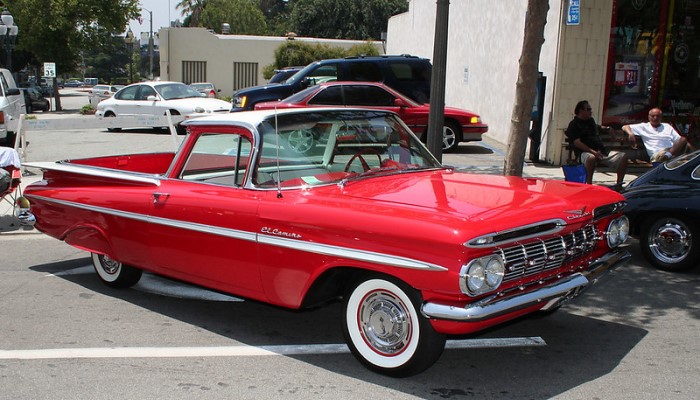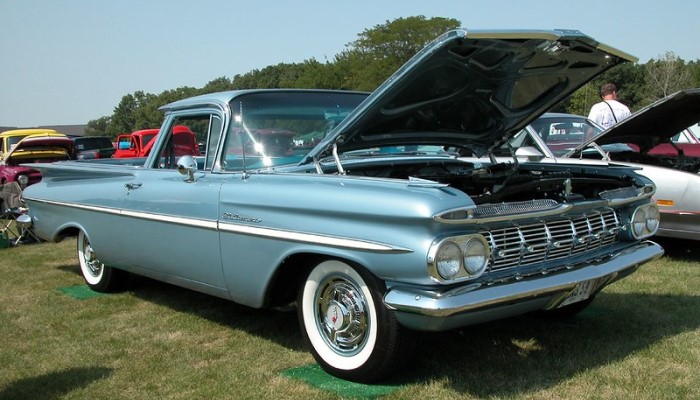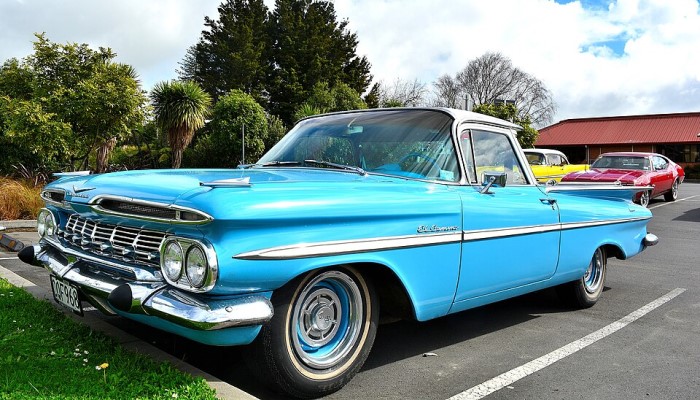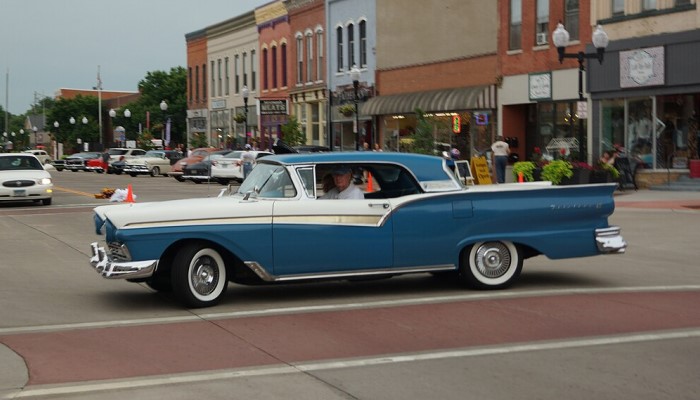1959-1960 Chevrolet El Camino

Photo: 1959 Chevrolet El Camino - red white - 1" by Rex Gray
Less Sleek, More… Ruggedly Charming!
Ever since Chevrolet began to overtake Ford in sales, starting in 1928 when the Model T was replaced by the Model A, General Motors' best-selling division had generally been able to launch models before its big rival. This included the first postwar pickup truck, which Chevrolet introduced in 1947, a year before Ford.
When Ford introduced the Ranchero in 1957, Chevrolet was stunned. Chevrolet knew Ford was preparing a pickup truck based on a car, but it had not expected the market to accept such a vehicle well and had no response in mind.
However, the Ranchero proved to be a success from day one. The Ranchero attracted the attention not only of farmers who could use it for work and commuting, but also of people who had previously driven station wagons and needed a smaller vehicle for delivering goods.
In its first year, 21,000 Rancheros were sold, and Chevrolet gave the green light to produce a competitor. Instead of a quick build, Chevrolet decided to take it slow and do a good job, so the El Camino didn't hit the market until 1959, or two years after the Ranchero.

Photo: "Chevrolet El Camino (1959)" by andreboeni
Ford used many parts from other cars to build the Ranchero. The idea seemed simple on paper, and it was expected that Chevrolet would just cut the roof off the station wagon and use parts from the convertible to make the El Camino.
However, when the El Camino was about to go into production, Chevrolet didn't have a single two-door station wagon. Many of the parts had to be custom-built, which led to high production costs, and in such cases, Chevrolet had to sell a large number of El Caminos to make a profit.
Based on the Chevy Impala
The El Camino was based on the Chevrolet Impala and came with several engine options. The base model had a 235 cid (3.9L) in-line 6 with 135 hp, followed by a 283 cid (4.6L) V8 version with two carburetors and 185 hp and a four carburetors and 230 hp.
For people who wanted a lot of power, there was the 348 cid (5.7L) that came in three versions, with power ranging from 250 hp to 315 hp.

Photo: 1959 Chevy El Camino" by Armchair Aviator
What made the El Camino special was the long list of optional equipment, and in its first year, 22,000 copies were sold and the El Camino overtook the Ranchero in sales. But, problems arose the next year.
The classic 1950s design with long tails and large dimensions was slowly going out of fashion and people turned to smaller cars. Realizing this, Ford based the new Ranchero on the small Falcon, but Chevrolet could not go down the same path because its only compact, the Corvair, had a rear engine.
Chevrolet tried to erase the 1950s image with the new El Camino, but there were no results and sales fell to 14,000 copies. Seeing that the compact Ranchero was a great success, with 21,000 units sold in 1960, and that the larger El Camino was selling poorly, Chevrolet decided to completely discontinue this model after only two years on the market.
A Price Tag That Might Surprise You
Imagine the scene: cruising down the highway, your prized poodle nestled in the passenger seat, a surfboard strapped to the bed (because, naturally).
The first generation (1959-1960), though, is a different beast entirely. Less sleek, more… ruggedly charming. Think of it as the slightly awkward, but undeniably lovable, cousin of its later, more refined siblings.
Finding a first-gen El Camino in today’s market is like searching for a unicorn wearing a tiny sombrero. They’re rare birds, and their prices reflect that.

Photo: File:1959 Chevrolet El Camino (36614548852).jpg" by GPS 56 from New Zealand
While a perfectly restored, mint-condition model can fetch a hefty sum (we're talking serious collector's item territory), you might find a project car – one that's seen better days, to put it mildly – for a significantly lower price. Think of it as an automotive fixer-upper with immense potential (and a whole lot of elbow grease required).
Let's break down those price ranges using this data:
Condition / Price Range (USD)
Show-Quality = $75,000+
Excellent = $40,000 - $75,000
Good = $20,000 - $40,000
Project Car/Parts Car = $5,000 - $20,000
Keep in mind these are broad estimates. Actual prices fluctuate depending on factors like engine type, original options, and the overall level of rust (a significant concern for cars of that era). You know what they say: Rust never sleeps… but it certainly eats into your El Camino's value.
As the great automotive sage, Jay Leno, once said (and I’m paraphrasing for humorous effect): "Investing in a classic car is like marrying a beautiful woman – it's expensive, time-consuming, and occasionally frustrating, but... Oh so rewarding!"
FAQ
Q: Are these cars reliable? A: Let's just say they're "characterful". Expect some maintenance, and embrace the journey.
Q: Are parts easy to find? A: Not as readily available as for later models. Patience (and perhaps a healthy dose of ingenuity) are essential.
Q: Is it a good investment? A: That depends entirely on your definition of "good investment." If you're looking for a quick profit, probably not. If you're seeking a unique piece of automotive history and a fun project, absolutely!
Q: Can I use it as my daily driver? A: Unless you're incredibly brave (or foolish), probably not. These are best suited for weekends and car shows.
So, if you're considering embracing the quirky charm of a first-generation El Camino, be prepared for both a rewarding and potentially pricey adventure. Just remember to factor in the cost of elbow grease, patience, and possibly a hefty supply of rust remover. Happy hunting!

Unique Car Zone Team
A group of several fans of everything that moves on four wheels, a few article creators, a couple of marketing strategists, designers, web developers, and lots of coffee.






